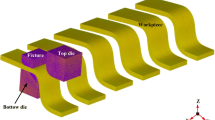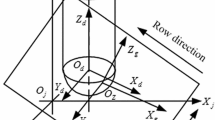Abstract
Many researches on mold wear are based on numerical simulation of single stamping, which is difficult to reflect the cumulative wear caused in the real continuous stamping process. By designing the stamping trajectory, a numerical simulation method based on continuous stamping is proposed. The modeling of the mold is analyzed and the formula of the wear amount is deduced. And a series of tests are designed to analyze the surface morphology which provided the theoretical and factual basis for numerical simulation and verifies the correctness of the numerical simulation method. Then the variation of heat, wear and stress field distribution during continuous stamping process are investigated by numerical simulation. The relationship between the stress and wear increment of the mold is studied. Finally, the variation rule of the wear amount after continuous stamping is summarized and the criterion of entering the steady wear state is given. The maximum wear depth is fitted linearly and the service life is predicted. This provides a theoretical basis for studying the wear rules of the dies in the continuous stamping process.























Similar content being viewed by others
References
Pereira, M.P., Weiss, M., Rolfe, B.F., et al.: The effect of the die radius profile accuracy on wear in sheet metal stamping. Int. J. Mach. Tools Manuf. 66(2), 44–53 (2013)
Subramonian, S., Altan, T., Ciocirlan, B., et al.: Optimum selection of variable punch-die clearance to improve tool life in blanking non-symmetric shapes. Int. J. Mach. Tools Manuf. 75(12), 63–71 (2013)
Okonkwo, P.C., Kelly, G., Rolfe, B.F., et al.: The effect of sliding speed on the wear of steel–tool steel pairs. Tribol. Int. 97, 218–227 (2016)
Slima, K.B., Penazzi, L., Mabru, C., et al.: Fatigue analysis-based numerical design of stamping tools made of cast iron. Int. J. Adv. Manuf. Technol. 67(5), 1643–1650 (2013)
Pereira, M.P., Yan, W., Rolfe, B.F.: Wear at the die radius in sheet metal stamping. Wear 274(3), 355–367 (2011)
Cora, Ö. N., Koç, M., Blau, P.J., et al.: Investigations on the effect of coating material and method on die wear in stamping of advanced high strength steels. ASME 2013 International Mechanical Engineering Congress and Exposition, pp. V02AT02A019 (2013)
Jie, C.: H13 steel surface wear behavior of the numerical simulation and die life prediction. Jilin University, Changchun (2015)
Ezilarasan, C., Kumar, V.S.S., Velayudham, A.: Theoretical predictions and experimental validations on machining the Nimonic C-263 super alloy. Simul. Model. Pract. Theory 40(1), 192–207 (2014)
Song, J., et al.: Cutting performance and failure mechanisms of TiB 2-based ceramic cutting tools in machining hardened Cr12MoV mold steel. Int. J. Adv. Manuf. Technol. 70(1), 495–500 (2014)
Tang, B., Wang, Q., Wei, Z., et al.: FE simulation models for hot stamping an automobile component with Tailor-Welded high-strength Steels. J. Mater. Eng. Perform. 25(5), 1709–1721 (2016)
Shi, D., Hu, P., Ying, L.: Comparative study of ductile fracture prediction of 22MnB5 steel in hot stamping process. Int. J. Adv. Manuf. Technol. 84(5), 895–906 (2016)
Cora, Ö.N., Namiki, K., Koç, M.: Wear performance assessment of alternative stamping die materials utilizing a novel test system. Wear 267(5–8), 1123–1129 (2009)
Wang, C., Xie, Y., Zheng, L., et al.: Research on the chip formation mechanism during the high-speed milling of hardened steel. Int. J. Mach. Tools Manuf. 79(4), 31–48 (2014)
Neto, H.K., Diniz, A.E., Pederiva, R.: The influence of cutting forces on surface roughness in the milling of curved hardened steel surfaces. Int. J. Adv. Manuf. Technol. 84(5), 1209–1218 (2016)
Lauro, C.H., et al.: Optimization of micro milling of hardened steel with different grain sizes using multi-objective evolutionary algorithm. Measurement 85, 88–99 (2016)
Zhang, Song, Guo, Y.B.: Taguchi method based process space for optimal surface topography by finish hard milling. J. Manuf. Sci. Eng. 131(5), 051003 (2009)
Wang, Y.Y., et al.: Investigation on affecting factors of vibration in milling harden steel assembled with different hardness. Key Eng. Mater. 546(5), 137–141 (2013)
Guillemot, N., et al.: Prediction of the endurance limit taking account of the microgeometry after finishing milling. Int. J. Interact. Des. Manuf. 4(4), 239–249 (2010)
Zhang, Chen, Zhou, L.: Modeling of tool wear for ball end milling cutter based on shape mapping. Int. J. Interact. Des. Manuf. 7(3), 171–181 (2013)
Qiaoqiao, G.: Adhesive Wear and Fatigue Wear of Materials. Mechanical Industry Press, Beijing (1989)
Johnson, K.L.: Contact Mechanics. Higher Education Press, Beijing (1992)
Jiangfeng, Zhu: Stamping Process and Mold Design. Huazhong University of Science and Technology Press, Hubei (2012)
Acknowledgements
Thanks to the support of National Nature Science Foundation of China (Grant No. 51775151) and the support of National Nature Science Foundation of China (Grant No. 51205096).
Author information
Authors and Affiliations
Corresponding author
Additional information
Publisher’s Note
Springer Nature remains neutral with regard to jurisdictional claims in published maps and institutional affiliations.
Rights and permissions
About this article
Cite this article
Zhang, W., Wang, S., Chen, J. et al. Experimental and continuous stamping simulation study on surface wear of hardened steel mold. Int J Interact Des Manuf 12, 1481–1494 (2018). https://doi.org/10.1007/s12008-018-0505-5
Received:
Accepted:
Published:
Issue Date:
DOI: https://doi.org/10.1007/s12008-018-0505-5




